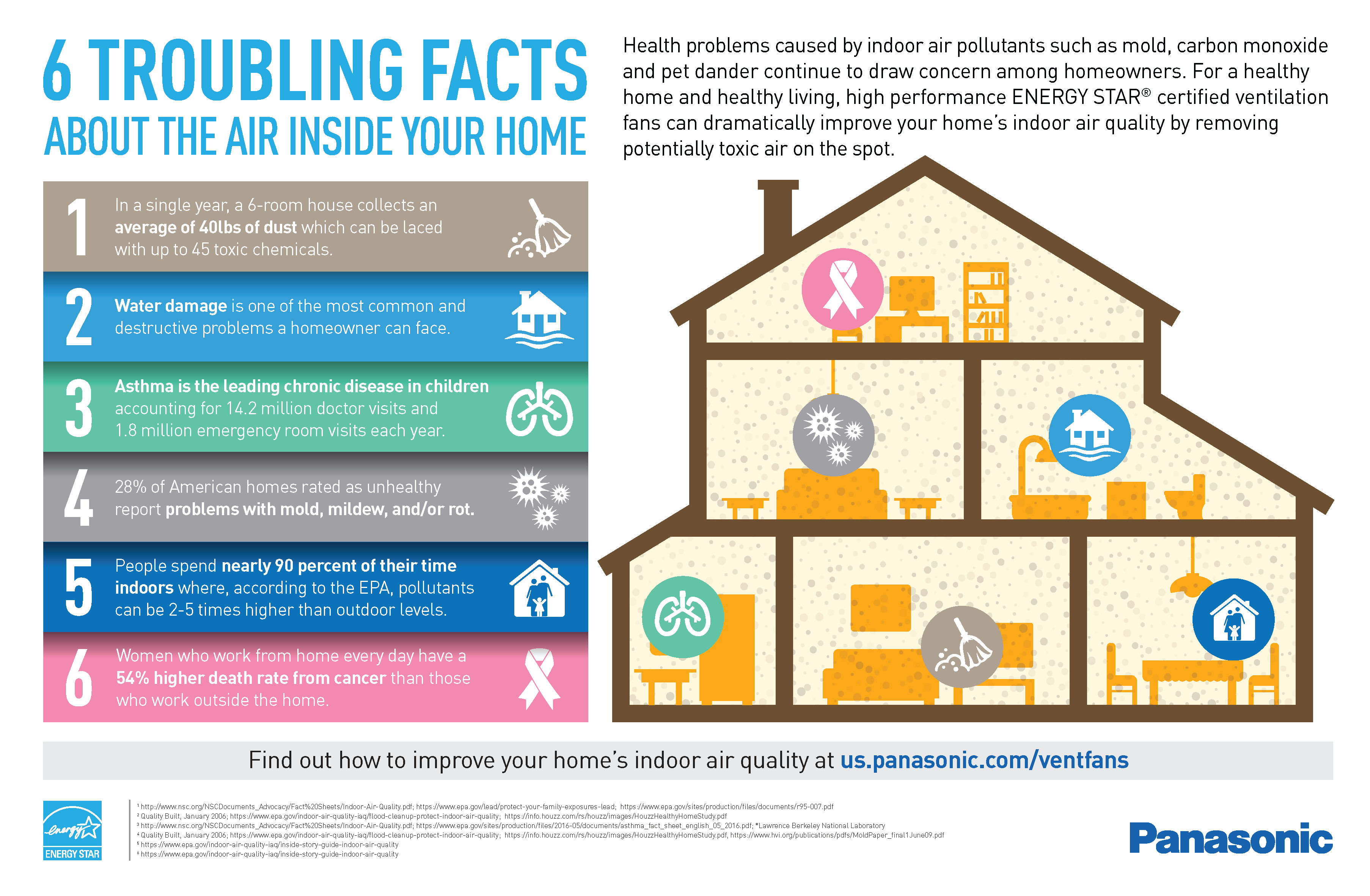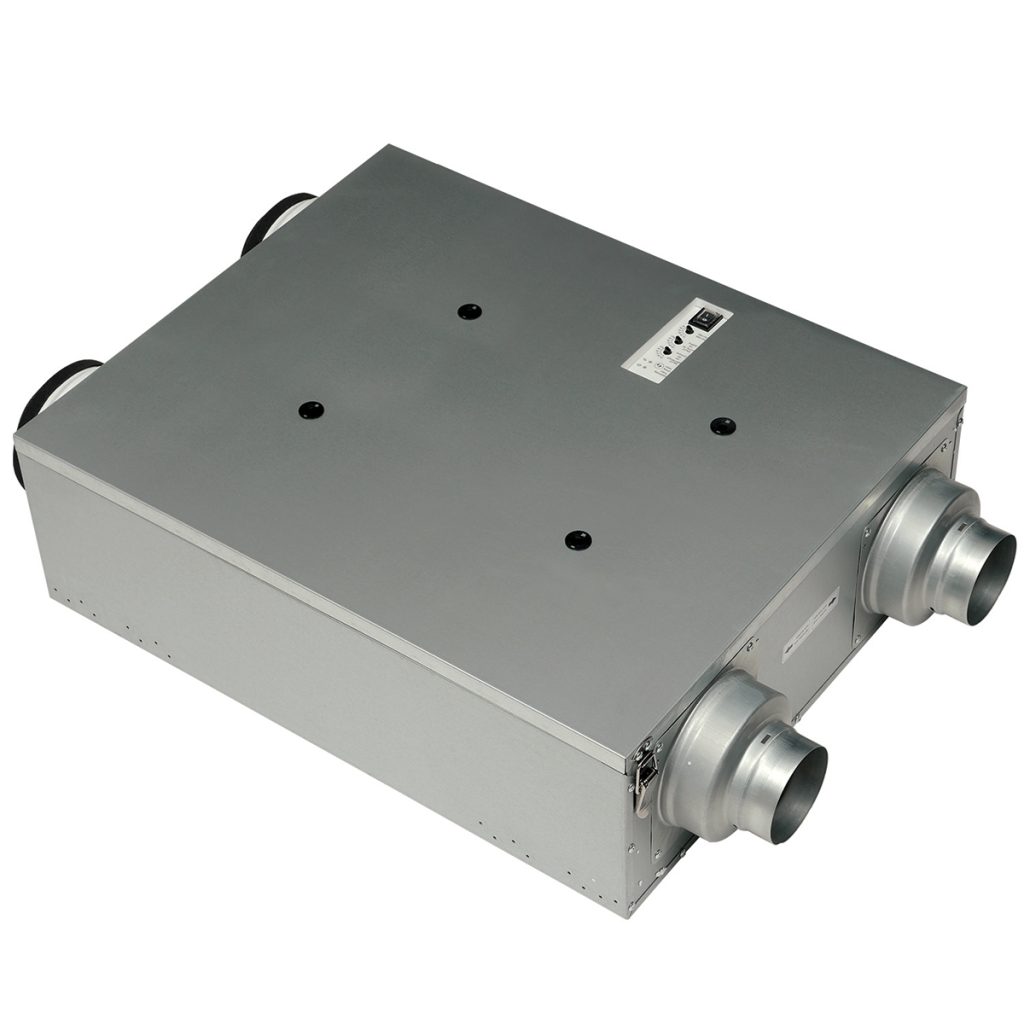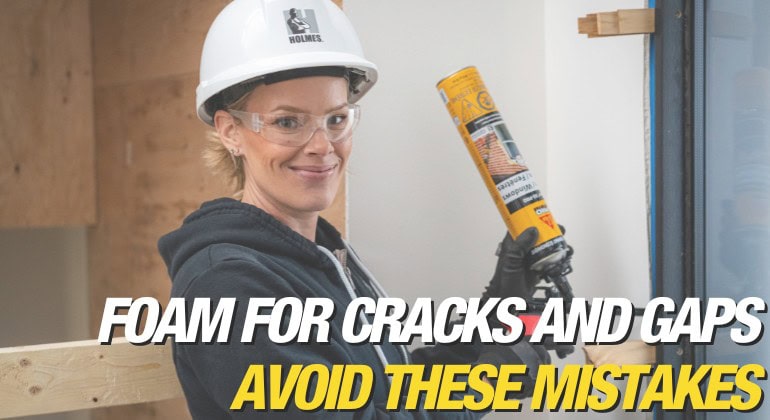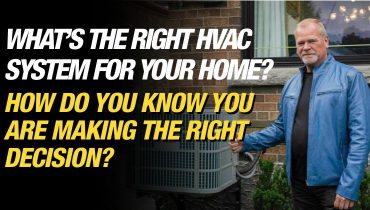When it’s time to replace your HVAC system, you have several options, each with its own benefits. Choosing the right HVAC system depends on your home’s size, climate, energy needs,...
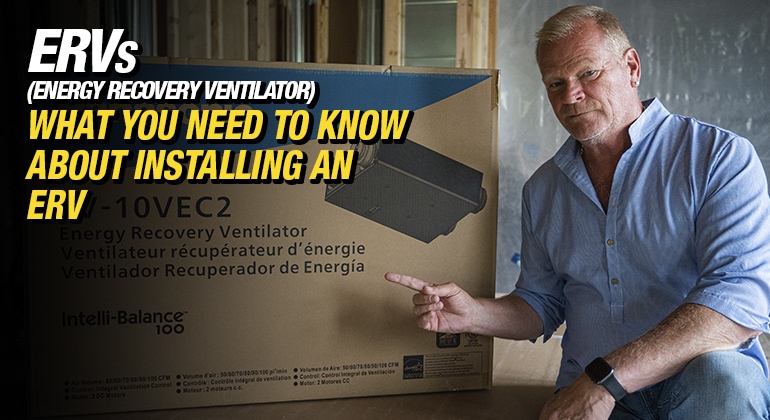
How Does An ERV System Work And ERV Benefits
By Mike Holmes
Mike’s Advice / Buying & Selling Your Home
Monday, September 26th, 2022 @ 12:24pm
What You Need To Know about an ERV System and How to Install It Right
For years, I’ve stressed the need for good indoor air quality, because a healthy home, means a healthy life. The quality of the air in our houses has a significant impact on how we feel on a daily basis. Do you suffer headaches all the time? Are you worried about allergies inside your home?
Excess humidity may get inside your walls and cause mould and damage to your walls and structure if your home isn’t properly ventilated. Installing a heat recovery ventilator, or even better, an energy recovery ventilator (ERV), is my number one recommendation for correctly producing an effective air exchange.

Installing a Panasonic ERV (energy recovery ventilator) in my home.
Here’s my guide on ERV systems and installing one in your home.
What is an ERV System?
You may be familiar with HRVs (heat recovery ventilators). However, an ERV(energy recovery ventilator) system can exchange both heat and moisture.
One way to improve your indoor air quality is to manage the humidity levels in your home. That’s why we talk about the importance of ventilation fans in your kitchen and bathrooms. An ERV system is an excellent way to improve your indoor air quality.
I just recently had the Panasonic Intelli-Balance 100 energy recovery ventilator installed in my crawl space. I’ve been meaning to install one for years, and finally got around to it when I started renovating my house. It is designed for new air tight homes built to meet energy efficiency standards and is Energy Star certified.
How Does an ERV System Work?
Energy Recovery Ventilators manage the humidity in the air being pulled into your home. In the winter, your ERV transfers humidity from the air extracted from your house, keeping your humidity levels relatively stable.
During the hot summer months, the opposite happens. Moisture is pulled out from incoming air. This reduces the work your air conditioner and dehumidifier do to keep things even.
Opening a window is good (and something I recommend you do EVERY DAY), but it isn’t practical during hot and cold months. An energy-recovery ventilator (ERV) helps keep your air fresh to give you a comfortable indoor environment. With an ERV, you have a constant exchange of air happening, giving you a steady supply of fresh air.
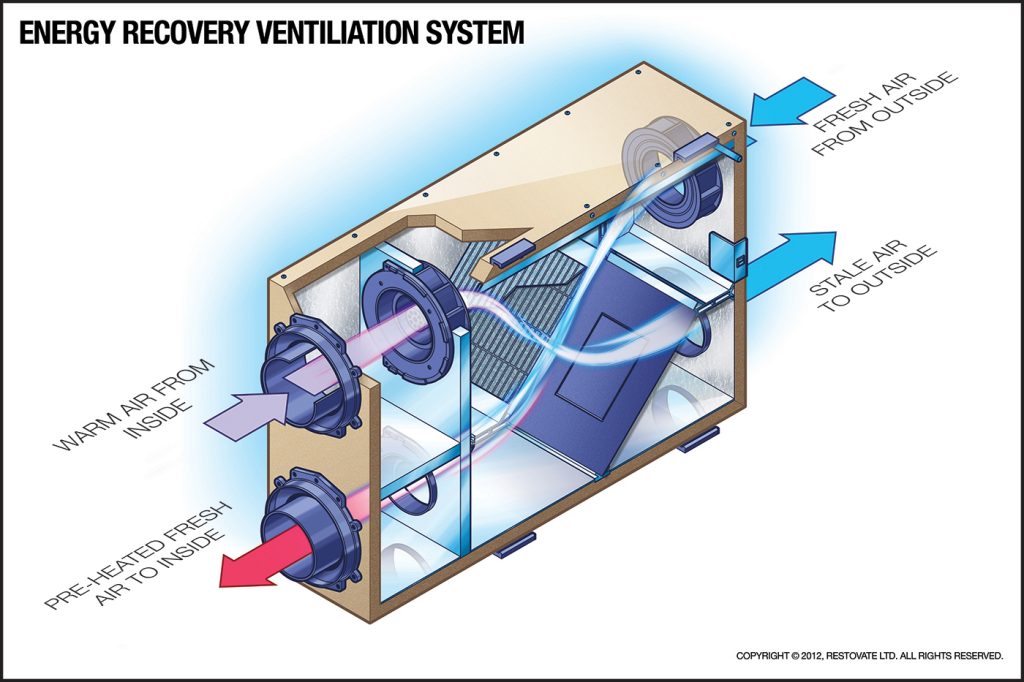
Illustration of how an Energy Recovery Ventilation System Works.
ERVs have two fans to create two independent air streams. The first one pulls fresh outdoor air into your home. The second expels stale and polluted indoor air outside.
As the two airstreams go through your ERV, heat, and moisture are transferred inside during winter and out during summer.
As we’re bringing in cold air from outside, the air that we have already warmed up inside our home returns back to our furnace.
Indoor Air Quality in Airtight Homes
Today’s homes are built to be airtight. That’s why a mechanical ventilation system is important to maintain healthy indoor air quality. Here is why:
- In an airtight home, you will feel the effects of no ventilation.
- Toxins and contaminants that are trapped in your home need to be removed from your house.
- Excess humidity needs to be expelled to help prevent mold & mildew in homes.
An ERV can recover thermal energy in exhausted air. It preheats fresh air in winter and pre-cools it in summer. So if you are paying high energy bills, an ERV can reduce them significantly.
RELATED
Here are 6 facts on poor indoor air quality in your home. Illustration by Panasonic.
Why You Should Install an ERV System – ERV Advantages
#1 Enhance Indoor Air Quality
With an ERV, you get indoor air that is always fresh and well-ventilated. When we talk about healthy indoor air, we are talking about moderate humidity, good oxygen levels, and low concentrations of airborne particles and harmful gases.
An ERV brings in fresh filtered air from outside while exhausting stale. polluted air from the inside. The Panasonic ERV that I personally install on my projects also has a patented exchange capillary core designed to transfer heat and moisture from indoor and outdoor air pass through.
When your ERV expels stale air out of your home, it also flushes out the pollutants contained in it. Your ERV also filters the outside air. This also grabs pollen, dust, and other outdoor pollutants before they can get inside your house. The result? Improved indoor quality.
RELATED
#2 Improve HVAC Efficiency
An energy recovery ventilator transfers heat energy between incoming and outgoing airstreams. It also effectively pre-cools or pre-heats the air entering your home. Your HVAC system now has less to do. This means it can run more efficiently, and you can enjoy lower energy bills.
The Panasonic Intelli-Balance ERVs use two (2) DC brushless motors with built-in SmartFlow™ technology. When the ERV senses static pressure, its speed is automatically increased to ensure optimal CFM output; regardless of a complicated duct run. I love that!
#3 Humidity Control – Keep the Moisture Level Consistently Safe
Lack of ventilation can cause a build-up of moisture in your home. This can lead to mildew and toxic mold growth. In a poorly ventilated home, you may also have air pollutants like carbon monoxide, carbon dioxide, radon, and volatile organic compounds (VOC).
If your home has low humidity, you may notice some shrinking or warping of hardwood surfaces. Low humidity can even have an effect on your personal health and cause dry, itchy skin, or even feelings of congestion.
If your home has high humidity, you could be dealing with mold and mildew, and potential damage to furniture, wallpaper, paintwork, floors, and brickwork.
An energy recovery ventilator manages moisture levels in your home as well.
I do want to note that an ERV is not a dehumidifier. If you want to dehumidify and ventilate at the same time, you may want to look at a whole-home dehumidifier.
RELATED
#4 Easy Maintenance
You can consult with an HVAC company to do your maintenance checks on your ERV and HRV. But there are basic steps you do yourself for maintaining your ERV:
- Remove the cover. Your ERV might have clips or screws.
- Remove the filters. These should come out fairly easily.
- Vacuum filters to remove most of the dust and household debris. The filter that takes the air coming in from outside tends to be dirtier.
- Wash in lukewarm water using a mild soap. You can do this in your laundry room or kitchen sink. Rinse thoroughly and shake filters to remove excess water, and then let them dry.
- Make sure the filters are dry before putting them back in.
- Remove the air exchanger and lightly spray with water to clean it. This should be done once a year.
Panasonic Intelli-Balance ERV Maintenance
The Panasonic Intelli-Balance ERVs have a hinged access panel. This allows for quick and easy product maintenance and filter checks. A convenient light indicator and unobtrusive alarm signal on the access panel will help inform the homeowner when it’s time to check and clean the filters. Both filters should be vacuumed with a soft brush attachment every 2-3 months or as needed, and the supply air filter should be inspected every 90 days and replaced every 6 months to maintain the ERV’s peak performance.
#5 Control Ventilation in Your Home
Opening up your windows for 15 minutes every day is a good idea. But when you do that, conditioned air from inside also leaves. That’s not good for energy consumption. With an energy recovery ventilator, you can control this process.
#6 Improve the Comfort of Your Home
The ERV can be controlled to manage the air exchange as needed in your home. One of the advantages is that stale air from your home is moved outside, which helps control humidity and pollutants in the home. It also brings fresh air in and removes stale air from your home, removing any bad odours. It also filters air coming in with either standard Merv 8, Merv 12 or HEPA filters which help to remove some doors coming in from outside fresh air. This creates a comfortable environment indoors. And NO ENERGY GETS WASTED.
RELATED
A lot of people will try to ventilate their homes by opening their windows and using a powerful ventilation fan. While it is always good to let fresh air in, remember that opening your windows also lets out all the warmth or coolness. And the fresh air coming in isn’t filtered. You may be inviting dust, pollen, soot, mould, and other pollutants into your home. An ERV brings moving fresh, filtered, temperature-controlled air into your house while removing stale, contaminated air.
What Is The Best ERV On The Market?
In my opinion, the Panasonic Intelli-Balance 100 ERV is the best one in the market. I installed this in a few Holmes Family Rescue projects, and recently in my own crawl space. Here is what I love about this model:
- The core material is permeated with anti-mold treatment to help prevent mold
- Connect to existing ductwork or use as a standalone, whole-house ventilation solution
- Built-in controls minimize the time it takes to determine the desired airflow, as well as verify and maintain performance. Love this.
- does not require connection to the Central HVAC or the addition of a condensation line.
- two (2) ECM brushless motors with built-in SmartFlow™ technology for precision ventilation. When the ERV senses static pressure, its speed is automatically increased to ensure optimal CFM output; regardless of a complicated duct run.
- A hinged access panel makes it quick and easy to do maintenance and filter checks.
Check out some of my top Panasonic Indoor Air Quality products.
Here is where you can buy the Panasonic ERV.
Panasonic ERV BOOST Technology
I love the BOOST function on the Panasonic ERVs. It increases airflow on demand. With the flip of a switch, even more effective. Think about when you host a lot of people in your home. You will need greater ventilation. The new occupant-controllable BOOST function increases airflow on demand. With the flip of a switch, two ECM motors with Smart Flow™ technology BOOST output power to provide healthier indoor environments.

Panasonic Intelli-Balance 100 ERV installed at my house.
ERV VS HRV
HRVs and ERVs are similar devices. They will both supply air to your home and exhaust stale air while recovering energy from the exhaust air during the process. The main difference between the two is that an HRV transfers heat and an ERV transfers both heat and moisture.
An ERV is ideal for warmer, more humid climates.
RELATED
ERV Components
The main components that make up your ERV, include:
- The rotary heat exchanger (wheel)
- Heat Pipes
- Plate heat exchanger Fixed Core Plates
- Turn Around Coils
Your energy recovery ventilator also has two filters. One that takes the air coming in from outside, and the other on the opposite side. It’s important to perform regular maintenance tasks on your ERV. In the spring and summer, you will find more dust and debris on your filters. If the filters are clogged, you will not get that full air exchange happening.
Your ERV also has an air exchanger. It looks like a box, and can also come out like your filters. One side of the air exchanger has a corrugated pattern. To put it simply, it takes the indoor air and passes it through to the other side. You also need to clean your air exchanger once a year with some light water spray. When these two streams of air pass through your ERV, a heat exchanger transfers heat and moisture from one airstream to the other.
Best Practices to Install an ERV System
Hire an HVAC contractor
Installing any HVAC system is not a DIY job. Always hire an HVAC contractor to install the type of ERV that is integrated directly into the home’s forced-air ductwork.
I recently had the Panasonic Intelli-Balance 100 ERV installed in my crawl space. I know a lot about construction, but I don’t install my own furnaces, ERVs or HRVs.
The basic steps for installing your ERV are:
- Mount the Main Unit
- Mounting diffusers on walls, not the ceiling
- Install the Diffusers of the ERV System in the Bathroom
- Install the Diffusers of the ERV System in the Kitchen

Panasonic Energy recovery ventilator with two (2) ECM motors and built-in SmartFlow™ technology.
RELATED
Electrical Concerns When You Install an ERV System
- Make sure that a separate power supply circuit is provided for your ERV unit
- Electrical work should be done by a licensed electrical contractor
- When wiring, position the wires so that the control box cover can be securely fastened. Improper positioning of the control box cover may result in electric shocks, fire, or the terminals overheating.
- The built-in Pick-A-Flow™ airflow selector lets you select your required supply (50-60-70-80-90-100 CFM) and exhaust airflow (50-60-70-80-90-100 CFM). This means you can create balanced, positive or negative pressure inside your home.
- Before touching the electrical parts of your ERV, turn off the unit.
Remember, it’s important to hire a Licensed Electrical Contracting (LEC) business to complete any electrical work needed in your home to ensure it’s done SAFELY! You can find an LEC here.
Installing ERV System In The Summer (Summer Humidity)
In the summer months, you may be running your air conditioner a lot. In a home with an air conditioner, the humidity levels outside are bound to be higher than inside. Your ERV will limit the amount of moisture coming into your home.
In the summer, an ERV system can reduce humidity in your home, which helps prevent mold growth and keeps the air feeling fresher.
Installing ERV Systems In The Winter
In the winter when humidity outside is low, your ERV will limit the amount of moisture LEAVING your house.
Should I run my ERV continuously?
You should not turn off your HRV or ERV unless it’s for servicing. HRVs and ERVs running continuously will ensure your home is well-ventilated and maintains good air quality.
ERVs are a great addition to your HVAC system as the units transfer and regulate the heat and moisture from your home, making your living environment much more comfortable. An ERV can also help remove toxins and contaminants from the air, improving your indoor air quality. All while being energy efficient when well-maintained, it will help you save money in the long run. In my opinion, it just makes sense.
READ NEXT
HRV vs ERV-Which One To Choose?
Indoor Air Quality Report from Panasonic North America

